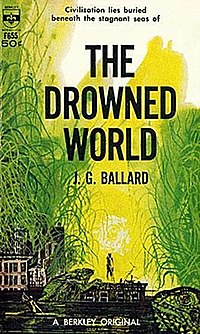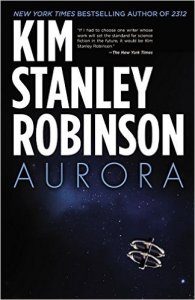Graham Sleight’s Yesterday’s Tomorrows: J.G. Ballard
By most orthodox standards, J.G. Ballard is not a very good writer. His characters are ciphers, his plots are straightforward and one book is often very similar to the next. It’s easy to see, also, why the SF community often had problems with his work: he was profoundly unconcerned with human efforts to understand or shape the universe. Indeed, if he said anything about such matters, it was that the universe was unknowable, incomprehensible, mysterious. So it was understandable – if a gross oversimplification – that his work was often labelled ‘‘pessimistic’’ or ‘‘dystopian.’’ And yet even those who accept all these criticisms would have also to accept that there was something about his work. Right from the start, he was a writer of absolute, transfixing certainty. Here, for instance, is the famous opening of his story ‘‘The Voices of Time’’ (1960):
Later Powers often thought of Whitby, and the strange grooves the biologist had cut, apparently at random, all over the floor of the empty swimming pool. An inch deep and twenty feet long, interlocking to form an elaborate ideogram like a Chinese character, they had taken him all summer to complete, and he had obviously thought about little else, working away tirelessly through the long desert afternoons.
One wouldn’t expect such things to be explained at the start of a story – though in this case, they’re not even explained by the end of the story. But what’s most distinctive about them is the sense that this is a world the writer knows utterly. He has chosen to show us this particular sight very deliberately. Why a drained swimming pool? Who knows: symbols in Ballard are often deliberately surreal, echoing Dali or Magritte more obviously than any logical schema. Yet one might suggest that a drained swimming pool is a useful emblem for some of Ballard’s obsessions: an achievement of money and ‘‘civilisation’’ now rendered obsolete and useless, being refitted for new and obscure purposes. As a short story, ‘‘The Voices of Time’’ resolutely refuses to make ‘‘sense.’’ Indeed, this kind of refusal – bordering on stubbornness – regarding orthodox narrative pleasures is one of Ballard’s hallmarks. Instead, we’re shown a series of other mysterious vignettes: a set of experiments into human genetics, a scrawled countdown towards zero, a series of gnomic proverbs. So far as anything unites them, it’s the idea that the universe is running down, or at least running out of human control. The most that any observer can do is watch and listen to ‘‘the myriad deaths of the cosmos.’’
‘‘The Voices of Time’’ can now be found in the vast The Complete Short Stories of J.G. Ballard (2009), but I prefer approaching Ballard’s stories through the collections in which they originally appeared. Partly, I admit, it’s because I get increasingly grumpy at huge volumes that are physically too big to read comfortably. But partly, also, a volume like The Four-Dimensional Nightmare is arranged with a great deal of care so that one story leads into the next. So ‘‘The Voices of Time’’ opens the book and is followed by ‘‘The Sound-Sweep’’ (1960) – which, as the title suggests, is also concerned with what might be tolerable and intolerable to hear, though in a very different context. There is also a clutch of stories about enclaves under threat, like ‘‘The Garden of Time’’ (1962), as well as ‘‘The Cage of Sand’’ (1960), one of Ballard’s first attempts to fit the space programme into his metaphysic.
Although their formal experimentation seems mild in comparison to much later Ballard, these stories seem utterly distinct from any other SF that was being written around this time, at least within the walls of genre publishing. As I’ve said, one could subject them to symbolic analysis, to try to tease out what each one ‘‘means.’’ But Ballard stories, I find, are mostly lessened by this kind of thinking. One needs instead to ask more general questions. What is the world-view of the person writing this story? How does he want me to see the things around me? How much am I convinced by the way of seeing he offers? It’s a very different set of questions from those prompted by, say, Heinlein or even Sturgeon.
The Drowned World was Ballard’s second novel, though he does not seem to have been keen on its predecessor, The Wind from Nowhere (1961). Certainly, The Drowned World was the first book fully to announce the kind of writer Ballard was going to become. And it foregrounds even more than the early short stories one of Ballard’s central concerns: landscape. The setting is London, but a London flooded and subject to tropical heat. Were the book published now, there would be obvious questions about whether it was meant to be a dire warning about climate change. Instead, it reads as a reaction against the ‘‘cosy catastrophe’’ books that at that time were prominent in British SF. The first chapter title, ‘‘On the beach at the Ritz’’ signals the kind of displacement from the norm that we’re going to see. The explanation for the increased temperature is offhand and beside the point: a ‘‘succession of gigantic geophysical upheavals’’ such as solar flares. What matters is the kind of place that London has become, and what Ballard’s protagonist Kerans can do about it.
As a writer of landscape, and as a seer of transformation in the everyday, Ballard is very likely unmatched. He’s peculiarly attentive to effects of light and colour, and some of the set-pieces in The Drowned World, such as the exploration of a flooded planetarium, are simply stunning. The story itself is perhaps more conventional, a series of squabbles between the inhabitants of the drowned London, but the overall affect is something new. It’s not merely that Kerans and his associates can do nothing to restore the old world. It’s that the landscape wins. Not in the sense of wiping out the humans, but in the sense that Kerans ultimately becomes a part of it. He ends up journeying south, ‘‘through the increasing rain and heat,’’ not because he will find anything new there but because of how completely he has ended up seeing. This is a world orchestrated by Ballard into symbols – the sun, especially, seems a constant presence throughout the novel. The protagonist, by definition, is the person who experiences most of them, and in a Ballard book, to experience the symbols is to want to become closer to them. (To engrave them on the floor of a drained swimming pool, say.)
So The Drowned World is an astonishingly radical book, at least compared to its contemporaries in the SF field. It’s not, however, perfect. Ballard has a sweet-tooth for invoking the surrealist painters in his descriptions; this often feels forced, as if it’s a short cut to the kinds of things he wants us to see. Similarly, once in a while he tells us too overtly what meaning we’re supposed to take from a given symbol – such as the description of the interior of the planetarium as ‘‘womb-like.’’ His peculiar and uncanny imagery is at its most effective when it’s not spelt out too much.
What followed was a series of novels that pursued similar science-fictional strategies, such as The Crystal World (1966). Then came an immersion in the formal experimentation of Michael Moorcock’s New Worlds. Out of this came the book of ‘‘compressed novels’’ The Atrocity Exhibition and, later, books like Crash (1973) and High-Rise (1975) set in something like the contemporary world. Like William Gibson much later on, Ballard’s career can be seen as a progressive homing in from overt science fiction towards the present day. (Or, as they both might say, an acknowledgement that the present day was inherently science-fictional.) Concrete Island comes from this period.
It’s also a novel of landscape, though in this case a sharply constrained landscape. Robert Maitland, an architect, is driving his car down the M40 in London when he has an accident. The car skids off the road, and he finds himself on the eponymous island, a walled triangular traffic island between the lanes of a motorway intersection. We’re meant to understand that Maitland is the sort of person who, in other circumstances, might be a pillar of society – a resourceful, competent type. So, at least for a stretch, the novel looks as if it’s going to be an ironic reimagining of Robinson Crusoe, with Maitland discovering how to survive in his strange new environment. It is partly that, of course, but there are other threads to it.
The first is a repeated sense that, though unusual, Maitland’s situation is somehow exemplary of urban life as a whole. The island is constantly framed by the motorway extending off to infinity; with it goes the suggestion that the city in general in constructed of such lines and their walls. The second is what emerges through the course of the story: the island has other inhabitants, and Maitland falls into a peculiarly intense dynamic with them. Behind every door in the city, Ballard seems to be saying, the same drama of dislocation and isolation might be playing out.
There’s nothing overtly fantastic about Concrete Island, except its affect. If you subject it to strict analysis, it’s not terribly believable. How could this ecosystem persist, so completely unnoticed? Could Maitland really survive, mentally and physically, in the way described? (There is at least the possibility that, though the book’s narrated in the third person, some of it is unreliable: might Maitland instead be hallucinating some of what he sees?) But the affect is what matters. Interstices like the island exist everywhere, and Ballard wants to make you see them. In that sense, Concrete Island is the sibling of a book like Miéville’s The City & The City.
The pivotal novel of Ballard’s career – though in no sense an SF book – was Empire of the Sun (1984). Directly drawing on Ballard’s own experience as an interned British prisoner in Shanghai during World War II, it serves as a kind of taproot for all his other works. The language of dislocation, of ‘‘normal’’ places transformed into something utterly strange, clearly starts here. So too does Ballard’s fascination with technology in general and flight in particular. After that came another installment of fictional autobiography, The Kindness of Women (1989), and a series of novels exhibiting a kind of late-period relaxation.
Super-Cannes (2000) is representative of these. Like much late Ballard, it’s an enclave story. The enclave in this case is Eden-Olympia, a business and residential development in the south of France for the very wealthy. Super-Cannes is much longer than the earlier books, at least in part because it takes its frame from another genre, the crime novel. Strange and deadly occurrences are taking place in Eden and the book’s protagonist Paul sets out to investigate why. Paul tells his story in the first person, but sounds like Ballard nonetheless:
Behind us, Marina Baie des Anges wrapped itself into the night, its curved towers enclosing a deeper darkness of sleep, dreams and seconal. We set off towards Antibes on the RN7, the beach of Villeneuve-Loubet to our left. A windsurfer tacked along the waves, watched by his wife and teenage son, sitting on the shingle slope below their parked car. As the sail caught the shifting air it seemed to vanish for a few seconds, then appeared again as if emerging from a defective space-time.
Of course, it’s that sudden evocation of something fantastic in the last sentence that makes this passage so distinctive. But other characteristic traits are there too: the sly, specifying punch of ‘‘seconal’’ at the end of the first sentence, the architectural eye, the immense sense of distance between the narrator and the other figures in this landscape. But there’s a new note here too: one can imagine the windsurfer’s family as happy in the present tense, and that’s not something one can say of the figures in many Ballard novels. It may be a small point, but I think it’s also significant that Super-Cannes is a novel where Ballard doesn’t indulge his usual tic of referring to characters by their surnames only. To be able to think of the narrator as ‘‘Paul’’ does make him a more rounded figure.
The plot of Super-Cannes, like the plot of many Ballard books, is almost superfluous. There is a cause behind what’s happening, and we discover what it is. But what stays with you is the depiction of Olympia-Eden and the kinds of lives that are carried out within it. It’s only partly a social satire, and far more a work of what might be called speculative observation. The book embodies a sustained argument about what it is to live in the here and now, an argument carried on in everything else Ballard wrote. That argument may seem strange, artificial, or unconvincing at times, but it can also seem utterly distinctive and transfixing. See the world as I do, he says, and lose yourself in it.











It’s absolutely true what you say about landscape in Ballard. Different writers evoke different things, of course. When you think of one you might thing of particular characters and their quirks or dillemas; whith another you might think of clockwork plots or filigrees of langauge; with Ballard, for me at least, his name always evokes a landscape. I don’t even know if it’s one that’s actually present in any of his works – if it is, I can’t remember it. But whenever I see his name, I instantly picture a large, towering, glass-panneled, impersonal commercial building. In the parking lot in front is a single car, a bright red convertible sports car with the top down. The sun glares off of everything, and no human figure is visible anywhere. And the whole thing is situated in…nothing. A bare, flat desert landscape extends all around…no roads leading in or out, with only a line of low mountains to bee seen in the far distance. That is Ballard for me. There is no other writer who so instantly evokes such a particular picture in my mind. I don’t know if that’s his talent, or my pathology!